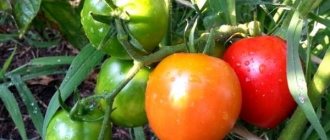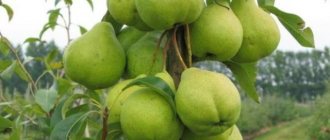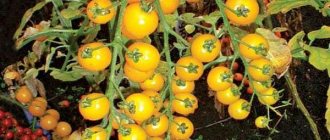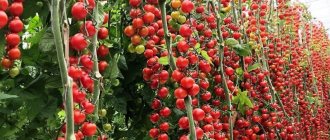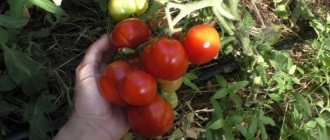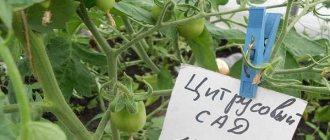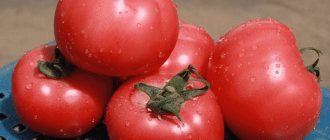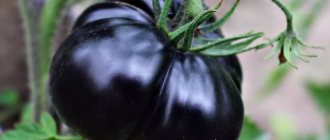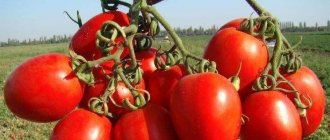Photos and features of standard raspberries
Standard raspberry varieties can reach a height of 2 meters. Large clusters of inflorescences form on each side shoot. Thanks to its thick stems and branches, the plant is able to support the weight of the fruit.
Standard raspberries have the following properties:
- do not crumble after ripening;
- have a pronounced taste and aroma;
- maintain integrity during long-term transportation.
Growing standard raspberries makes it possible to get maximum yield from small areas.
Standard plants: features of formation and care
Of course, you can experiment with plants, but these examples will probably be successful. The formation of such trunks begins during the period of rapid growth of young seedlings. During the growing season, side shoots are plucked out. Experts assure that the best standard plants are formed from trees/shrubs grown from seeds.
When growing a seedling, make sure that the trunk of the plant is strictly vertical, so that there are no so-called rings or bends on it
What is a standard?
The trunk is the part of the trunk from the root collar to the first branching of the frame branches. Standard raspberries resemble a tree in appearance.
When cultivating plants, do the following:
- Leave one stem.
- A lush crown is formed from side shoots.
- Remove root shoots and excess branches.
Although standard raspberries grow less, you cannot fool nature. Without proper care, root growth will appear. The raspberry bush will overgrow like ordinary wild shrubs.
Interesting. Because of their appearance, standard varieties are often called raspberry trees. But it's not right. The shape of a tree appears and remains that way only thanks to the efforts of gardeners.
Features of caring for the standard form
For many gardeners, planting a trunk is a tempting offer. But do not forget about the specific care that a plant with this crown shape requires. In addition to traditional watering, weeding, fertilizing and loosening, one cannot do without special pruning and special preparation of standard-shaped garden plantings for winter. In order for the plant to live up to its name and maintain its decorative form, it is necessary to completely exclude the growth of shoots. Experts monitor this with the utmost rigor. Wild shoots grow quickly, and can also make themselves felt not only along the length of the trunk, but also below the graft, and can even be visible from under the ground. The shoots are more viable; they are cut off at an early stage of emergence, otherwise the grafted part of the plant will stop receiving nutrition and simply dry out. Wild young shoots are especially dangerous during the first 3-4 years.
The standard in landscape design is valued not only for its beauty and originality of appearance, but also for its immunity to many diseases. A tall trunk becomes an insurmountable barrier to those pests and diseases that spread along with the soil and during watering. The advantages of this crown shape do not end there. At the very top, drafts and sunlight become more accessible. This also eliminates pain and allows you to maintain a decorative and sophisticated appearance.
Almost all standard representatives of the flora do not tolerate frost well. The trunks of elm, rowan, apple and maple are winter-hardy. Preparation for winter involves bending them to the soil. For roses, in this case, carefully dig up the root system. The grafted part can be trimmed (up to 20 cm is left) and covered together with the root. They use spruce branches. But a bush or tree cannot be bent down. They are carefully tied with non-woven fabric.
The best varieties of berries
Currently, there are many varieties of standard raspberries. The most popular among domestic gardeners are:
- Tarusa is one of the most popular varieties. The standard is tall, 1.2 meters high. There are almost no thorns on the branches. The fruits are conical, with small seeds, weighing up to 15 g, and tolerate transportation well. A distinctive feature of the variety is dark green leaves with a corrugated plate. The plant tolerates frost well;
- Galaxy is a variety with tall, compact bushes and a long fruiting period. The ripening periods are mid-early. The fruits are large, dark red in color, with a lot of juice, but do not tolerate transportation well;
- Sturdy - reaches two meters in height. It has a medium early ripening period. The berries retain their appearance during transportation. It is characterized by frost resistance and productivity. The fruits have the appearance of a flattened cone. The weight of the berries is 7–9 grams;
- Skazka is a mid-season variety with high yield, up to 12 kg per bush. The fruits do not deteriorate during transportation and are little susceptible to rotting;
- Penguin is a remontant medium-sized variety. The weight of the berries is 4–6 grams. The fruits retain their shape during transportation. Does not tolerate frost well.
All of these varieties are highly resistant to diseases.
Rating of the best varieties
Selection does not stand still. Traditional varieties are being replaced by new ones - earlier and more productive, resistant to diseases and the vagaries of bad weather. Without abandoning the reliable and familiar assortment, one cannot deprive attention of new items.
For greenhouses and greenhouses
Greenhouse and greenhouse standard tomatoes are heat resistant. They set consistently even at high temperatures and changes in humidity. In protected soil, mid-early and mid-ripening varieties can be cultivated - the most productive ones, including large-fruited ones.
Cheerful gnome
A modern Russian variety from breeder L. A. Myazina. The ripening period is medium-early (from 100 days). The bushes grow no higher than half a meter. Foliage is sparse. The tomatoes are sweet, deep red, weighing up to 100 g, elongated-cylindrical (10-12 cm), pickling type. The consistency is fleshy, not watery. One plant produces up to 2 kg of tomatoes.
See also Features of cultivation, characteristics and description of the tomato variety Chio Chio San
Orange cap
Cherry type (weight 16-20 g). Tomatoes are ovoid or spherical, amber-orange, sweet in taste. The bushes are low and extremely compact. The variety is suitable for pot culture and compacted plantings.
Gnome Purple Heart
A tomato of Canadian origin from the “Gnomes” series. Plants are stocky, half a meter in height. The fruits are shaped like a heart or a gnome's cap. The color is non-standard, purple-chocolate or brownish-burgundy, with a greenish tint. The average size of tomatoes is 110-145 g, the record size is 450 g. The pulp is sweetish, salad type.
Gavroche
Super early (80 days), low (45 cm) tomato from Russian agro. This is a cocktail variety, with sweet tomatoes weighing 50 g. They are round, even, bright red. The productivity of each bush is from 1 to 1.5 kg. A thick planting (30 x 30 cm) is recommended. The main purpose of the variety is whole-fruit pickling.
Antoshka
An early ripening variety with egg-yellow, sunny fruits. The size is slightly larger than a cocktail (on average 60-80 g). Tomatoes are round, sometimes slightly flattened at the top. The variety is attractive for its sweetness, which is rare for early tomatoes. The pulp is juicy. The height of the stems does not exceed 0.6 m. Fruiting is long-lasting, including on numerous stepsons. The bushes can be attached to a support or grown without a garter, as a semi-ampelic crop.
Advantages and disadvantages
The main advantage of standard raspberries is their high yield. Other advantages of the variety include:
- frost resistance - many varieties tolerate frosts down to -30;
- good fruiting regardless of weather conditions;
- ability to withstand light shading without loss of yield;
- disease resistance;
- large size berries.
The powerful stems of remontant varieties can withstand a large weight of fruit. They do not break even with a bountiful harvest. Therefore, no garter is required for cultivation. This makes it easier to care for and reduces the cost of maintaining a raspberry tree.
The disadvantage is the need to allocate more space for one plant in a raspberry garden than when growing conventional varieties.
Important. Standard raspberries produce fewer offspring for propagation. There are enough of them to replace old bushes and expand the raspberry tree. However, it is unlikely that it will be possible to quickly and significantly increase planting areas using your own material.
The best varieties and their characteristics
Breeders managed to develop about 100 varieties of standard tomatoes. Several dozen varieties are suitable for planting in the middle latitudes of Russia. They are characterized by high productivity, resistance to unfavorable conditions, and a low degree of damage to fungal diseases and pests.
Yield varieties
If tomatoes are grown for further sale or for mass canning, then it is better to give preference to productive varieties. There are many types of tomatoes that produce rich fruit with excellent taste.
Severin is a mid-season tomato variety with an average ripening time of 100-150 days. The stem grows up to 50 cm. The elastic, dense shell protects the tomatoes from cracks. Fruit weight is 60-80 g. Even cut, they hold their shape perfectly. The fruits are stored for a very long time. Severine is used for making sauces, pastes, juice and fresh.
Betta is an early-ripening, low-growing variety of tomatoes, suitable for planting in open ground and in greenhouses. You can also try growing tomatoes at home, for example on the balcony in containers. The period from the first shoots to the ripening of the fruit is 80-90 days. The height of the bush is no more than half a meter. The fruits have a round shape and smooth skin; when ripe they become red in color with a pronounced tomato taste. Fruit weight up to 80 grams. In conditions of good yield, up to 2 kg of fruit can be collected from one bush. Tomatoes are suitable both for consumption raw and for processing.
Polar. An early ripening variety, resistant to cold, so it is excellent for growing in harsh Russian conditions. It is grown by seedlings and planted in open ground. The time from germination to the first fruits is 110-112 days. The bush grows up to 70 cm in height. The fruits are red, round-flat in shape, weighing 60-100 g, sometimes reaching up to 160 g. The taste is sweetish with sourness. The fruits are used fresh or canned.
For open ground
The choice of tomato varieties for open ground should be based on the region in which they will be planted and what its natural and climatic conditions are. They also pay attention to the resistance of standard tomatoes to the main diseases of vegetable crops.
Alpha. Determinate variety, grown in open ground without seedlings. The bush grows up to half a meter, the fruits are round, slightly flattened with smooth skin, weighing up to 80 g. The ripening period is 85 days from the moment the first shoots appear. They have good taste, are juicy, suitable for fresh consumption and processing, but not for whole-fruit canning.
Shuttle is an early ripening variety of determinate type. Ripening time is from 95 to 110 days under conditions of planting in open ground. If you grow tomatoes in a greenhouse, the fruits will ripen two weeks earlier. The compactness of the bushes allows you to grow tomatoes in flower pots. The fruits have a cylindrical elongated shape, red color, each weight is 50-60 g. The harvest can be harvested throughout the summer, because The fruits ripen gradually. From one square meter you can harvest up to 8 kg of tomatoes.
Standard tomato variety Shuttle
Gavroche. A standard ultra-early variety of tomatoes, semi-determinate type, belongs to cherry tomatoes. Almost 90 days pass from the moment the seedlings are planted in open ground until harvest. Compact bushes grow up to 60 cm in height. The fruits are red in color, have a regular round shape, with a smooth, dense skin that is resistant to cracking. The weight of the fruit is up to 50 g, the taste is sweetish with sourness. Tomatoes can be eaten fresh, processed, canned and pickled.
Standard tomatoes for greenhouses
Standard tomatoes are intended for growing mainly in open ground. However, if farming is limited in the region due to inappropriate natural and climatic conditions, greenhouses are used to grow vegetable crops.
Orange hat. The variety is early ripening. The bushes grow up to half a meter in height. The fruits ripen 80 days after planting. They have a sweetish-sour taste, orange or yellow color, round shape with smooth skin. Each ripe fruit weighs 30-40 g. The orange cap is used for salads, canning, pastes and sauces. The disadvantage of this variety is its poor preservation. After harvesting, tomatoes should be used immediately for their intended purpose.
Andreevsky Surprise - refers to late-ripening varieties, produces the first harvest 4 months after planting the seeds. The bushes are quite tall, up to 2 m, so when planting they have to be tied to supports. The average yield is 5-8 kg per bush. The fruits are large and heavy, round-flat in shape with slight ribbing. Each tomato can weigh up to 800 g. After full ripening, the tomatoes become a rich pink color. The pulp has a rich taste, which makes it possible to use Andreevsky Surprise for salads and preparations. The productivity of tomatoes cannot be called high, but this is compensated by their size and taste.
Cheerful gnome. This is an early-ripening variety of tomatoes for greenhouses, suitable for growing in short and cool summers. During this period, the tomatoes have time to fully ripen and become saturated with nutrients. The bushes are low-growing, up to 40 cm in height. This feature allows you to grow them on the balcony and in flower pots. The fruits are elongated, approximately 10-12 cm, after ripening they become bright red, each weighing up to 90 g. The thick skin makes them suitable for storage and transportation. The Cheerful Gnome makes delicious preparations, sauces and fresh salads.
Early species
The advantage of early tomato varieties is that they ripen at the beginning of June. They are most often grown for further sale, when ordinary tomatoes are just starting to throw out inflorescences.
Oak. Very tasty fleshy fruits weighing up to 100 g. Bushes up to 60 cm in height ripen after planting on the 110th day. The color of the tomatoes is red. The shape is round, slightly flattened. In one square meter you can harvest up to 6 kg of crop. Tomatoes are used fresh, as well as for winter preparations and ketchup.
Pink leader. Early ripening tomato, ripening period 85-90 days after the first shoots. The height of the bushes does not exceed 55 cm. Ripe fruits acquire a deep red color with a pinkish tint. The weight of one tomato reaches 150-170 g. The shape is round with a slight flatness. From one square meter you can harvest up to 12 kg of tomatoes.
Fighter. An early ripening tomato with a ripening period of 95-100 days. The growth of the stem does not exceed 150 cm in height. The yield per square meter is 10-11 kg. The fruits grow plum-shaped, colored red, the weight of one reaches 80-200 grams. Shelf life is limited; it is not recommended to transport them over long distances.
Standard tomato variety Fighter
Gold. Early ripening tomatoes have a higher content of nutrients and vitamins. Yellow fruits do not have red pigment. Therefore, they become an alternative for people with allergies. The ripening period is 95-100 days. The weight of the fruit is up to 150 g, they have a round, flattened shape with slight ribbing. Juicy and aromatic pulp allows tomatoes to be used in salads, pickling, juices and sauces.
Planting and care
Raspberries are planted in rows. The row spacing should be 1.5-2 meters (depending on the height of the variety). The more the plant stretches, the greater the distances between the rows should be. Otherwise they will obscure each other. The distance between individual specimens in a row is 60-100 cm.
For standard raspberries, the tape method is best suited:
- Dig a trench 50-60 cm wide and half a meter deep.
- The bottom is covered with coarse organic matter: wood chips, sawdust, small branches, boards, paper, and leaf litter. Cover with a 10 cm layer of soil.
- A nutrient mixture is poured into the trench: humus with local soil 1:1. If the soils are heavy, coarse sand is added to the composition.
- Holes are dug in prepared trenches.
- Seedlings are inserted into them and dug in. When the hole is filled with earth, the seedlings need to be held slightly suspended so that the roots do not become crushed.
- After planting, the plant is watered from a watering can (10-15 liters per bush).
If planting material from containers is used, the plants need to be shaken a little before planting. This way the roots will straighten out.
Important. When planting, the soil is not enriched with nitrogen: mineral fertilizers or manure. An excess of this element impairs rooting. It is better to add it when the seedlings take root.
Grafting method
You can get beautiful trees by grafting. But this option requires much more effort and time. You need to purchase two seedlings - a rootstock and a scion. The first will be used as a standard, and the crown will be formed from the second.
Although both trees should be from the same crop, it is better to choose one stronger than the other. A rose can be grafted onto a rosehip, but a rough elm is suitable for a weeping elm.
But sometimes seedlings of different crops are used. This is a more difficult method, since it is not always effective.
The standard can be decorative, and the scion can be fruitful. In this case, fruits will appear on the tree a little earlier - already in the third year after planting.
During vaccination, you also need to follow some rules:
- first you need to grow a standard;
- then the tree is grafted;
- an oblique cut is made above the upper bud of the scion;
- the resulting wedge is inserted into the standard;
- after a month, new shoots are pinched.
Watering
Although raspberries love moisture, they should not be allowed to become waterlogged. Otherwise, the roots will rot and fungus may appear. Lack of moisture leads to growth retardation, a decrease in the number of fruits and a deterioration in their quality.
Raspberry seedlings are watered when the top layer of soil dries 5-10 cm. Watering rules:
- in case of frequent rains (every day or two), you can refuse watering;
- in dry weather, water raspberries 2-3 times a week;
- During the fruiting period, daily moisturizing may be necessary if the weather is dry.
On average, 30-40 liters of water are applied per plant.
On a note. If possible, it is better to organize drip irrigation. This will give the plants enough moisture and prevent diseases.
Standard plants: four main rules for formation and care
We form the crown gradually: every three to six weeks the shoots are shortened, because of this new branches will grow. Perfection of form is one of the main characteristics of true beauty.
This statement is also true in the issue of site design. The standard form of shrubs is gaining more and more popularity: there is probably not a gardener today who would not like to see this innovation on his site. Judge for yourself - an exquisite plant, full of triumph and natural elegance, with a rounded shape on a thin stem. Such beauty will delight the eye of both the owner of the site and his guests. Four rules for creating standard plants and caring for them are given below.
The shoots need to be pruned until the tree has grown sufficiently and its trunk has become sufficiently thick
Rule 1. With or without grafting - we listen to experienced gardeners
The process of forming a standard plant is a rather labor-intensive process. Typically, it will take a gardener five years to achieve the desired result. How to do this with vaccination?
The algorithm is not that complicated:
- The first step is to grow the standard, meaning the tree trunk itself. This can be either a native column or taken from a taller plant.
- After two years, the desired plant can be grafted onto this standard post. Creeping shrubs are often grafted onto a standard tree to create unusual, beautiful weeping forms.
Grafting onto a standard forming agent is an interesting and simple method. The trees obtained as a result of this method will decorate any garden and will be beautiful and healthy.
The top of the shoot needs to be trimmed only when the desired height of the tree has been reached.
The sun will fall better on the crown, and good lighting, as is known, prevents many plant diseases.
However, you can do without vaccination. In this case, correct formative pruning will help out. We grow the trunk again, having previously selected one central shoot (you can have two, of course, or even three braided). Excess branches will be gradually trimmed off regularly. This is done more than once a year, and the standard we need will be formed in more than one year. If necessary, the stem is tied to the support. The crown is formed using pinching. This means the tops of the shoots are pinched.
Some gardeners form a standard plant from an existing adult bush. The method is simple - all excess is cut off. But you need to do this if you don’t feel sorry for the bush at all, because the first experience may not be so successful. This tree is quite interesting.
Consider the second season from grafting - at this time you will receive an already formed standard seedling
Rule No. 2. The most suitable standard plants for formation
With simple pruning you can get a standard plant from:
- Maple
- Pines
- Bird cherry
- Juniper
- Yew berry
- Rowan trees
- Common privet
Of course, you can experiment with plants, but these examples will probably be successful. The formation of such trunks begins during the period of rapid growth of young seedlings. During the growing season, side shoots are plucked out. Experts assure that the best standard plants are formed from trees/shrubs grown from seeds.
When growing a seedling, make sure that the trunk of the plant is strictly vertical, so that there are no so-called rings or bends on it
Spiral shape of the trunk (video)
Rule No. 3. We do everything consistently
- When growing a seedling, make sure that the trunk of the plant is strictly vertical, so that there are no so-called rings or bends on it.
- If the shoot deviates from the vertical, tie it to a peg. Be sure to remove side shoots. You can also pinch them after the third leaf and then remove them after a year.
- In three to four years, a trunk one and a half to two meters high will grow from the seeds. A standard of young seedlings will grow a year, or even two, earlier.
- After mid-April, it is best to get vaccinated. To do this, take a cutting with 3-4 buds. In four weeks (or maybe three), buds will appear on the graft that has taken root. By autumn they will already become annual growths.
- Next spring you will need to cut them back into several buds in order to branch better. Subsequent care will be the same as for ordinary seedlings.
Consider the second season from grafting - at this time you will receive an already formed standard seedling.
The formation of such trunks begins during the period of rapid growth of young seedlings
Rule No. 4. Follow fashion - more miniature trunks on the site
Miniature trunks are a trend in garden fashion. But all their beauty will only be emphasized by correctly chosen undergrowth. Its task is to hide the soil near the stem. The undergrowth looks elegant, repeating the color of the leaves or flowers of the standard plant itself. If it matches the shape of the leaves or inflorescences, the result will be amazing. This beauty will also be a magnificent decoration of the garden.
Decorative mulch can also serve as undergrowth. For example, crumbs, pebbles, gravel.
Grafting on a standard forming agent is an interesting and uncomplicated method
So, to get an elegant standard plant - a real decoration of the site, you need:
- Select a young plant with a central straight shoot, remove all running shoots, tie the trunk (trunk) to a support;
- The shoots need to be pruned until the tree has grown sufficiently and its trunk has become sufficiently thick;
- The top of the shoot needs to be trimmed only when the desired height of the tree is reached;
- We form the crown gradually: every three to six weeks the shoots are shortened, because of this new branches will grow. This will gradually create a spherical crown.
Good luck with your site transformation!
DachaDecor.ru
Top dressing
Regular application of fertilizers is the key to a good harvest:
- in the spring, mullein is added under the bushes - 1 liter per bucket of water, or half a bucket of rotted manure and several glasses of ash;
- The first summer feeding is carried out at the end of May, beginning of June. Apply ready-made complex fertilizers for the growing season. You can make the solution yourself: 1 liter of mullein, 50 grams of superphosphate, half a glass of ash, 30 g of potassium sulfate diluted in 10 liters of water.
- the second time in the summer, fertilizers are applied during the flowering period. A mixture of superphosphate and ash is used, one glass each with four tablespoons of urea;
- in the fall you can add humus (half a bucket), or make a mixture of 2 tablespoons of superphosphate and a glass of ash.
All of these mixtures and solutions are designed to fertilize one square meter of raspberry trees.
Trimming and garter
To form a “tree”, the Sobolev method (double) is used:
- The top of the main stem is cut off by 20 cm when it grows to 90-120 cm.
- In June-July, the upper part of the side shoots is removed so that they are the same length as the trunk.
- In the spring of next year, cut off old shoots by 5-10 cm.
To prevent the bush from becoming overgrown and its branches not shading each other, you need to leave 3-7 branches and cut off the excess ones.
Mulching
Laying mulch is an important stage in caring for standard raspberries. Good mulching has the following properties:
- delays moisture evaporation. This allows you to reduce the frequency of watering;
- prevents soil compaction. It can be loosened less often;
- makes it difficult for weeds to grow. With a sufficient layer of mulch, you can forget about weeding altogether;
- In winter it protects the plant from frost.
To mulch raspberries, you can use straw, seed husks, and cardboard.
Preparing for winter
Before wintering, the following activities are carried out:
- remove the root shoots, leaving 3-4 layers;
- cut off diseased and damaged parts of the plant;
- mulch the soil abundantly.
Since the stems of standard varieties are quite dense, they are not stacked. Therefore, when choosing a variety, you need to pay attention to winter hardiness. It will not be possible to hide the shoots from frost.
Pests and diseases
Standard varieties are susceptible to the same diseases as regular raspberries. However, gardeners note the high resistance of these species to diseases. It is better to prevent problems than to fix them.
Raspberries are treated for prevention:
- in early spring - Bordeaux mixture (3% solution) to fight infections;
- before flowering - Topaz;
- when insect pests appear (even in small quantities), use fungicides.
In order to detect diseases in time, you need to regularly inspect the raspberry plant. If wilting, yellowing or spots appear on the leaves, remove the diseased parts of the plant. Treat with Bordeaux mixture. If this does not help, it is better to remove the bush to avoid massive infection of the garden.
Important. Proper agricultural practices will help prevent plant diseases. Timely watering, regular fertilizing, and a large distance between rows will improve the functioning of the plant’s defense mechanisms.
Reproduction methods
Raspberries are propagated in the usual ways: by root shoots and cuttings. In the first case, the young cuttings that appear next to the mother bush are carefully dug up. Then they are planted in prepared soil.
When propagating by cuttings, do the following:
- Carefully dig around the bush.
- Select a lateral root with formed buds.
- They are planted in containers with sand and peat soil.
- After germination, the bushes are transplanted to the site.
In spring and summer, cuttings can be planted directly into the ground. However, this reduces the survival rate of the plant, and gaps may remain in the raspberry tree.
